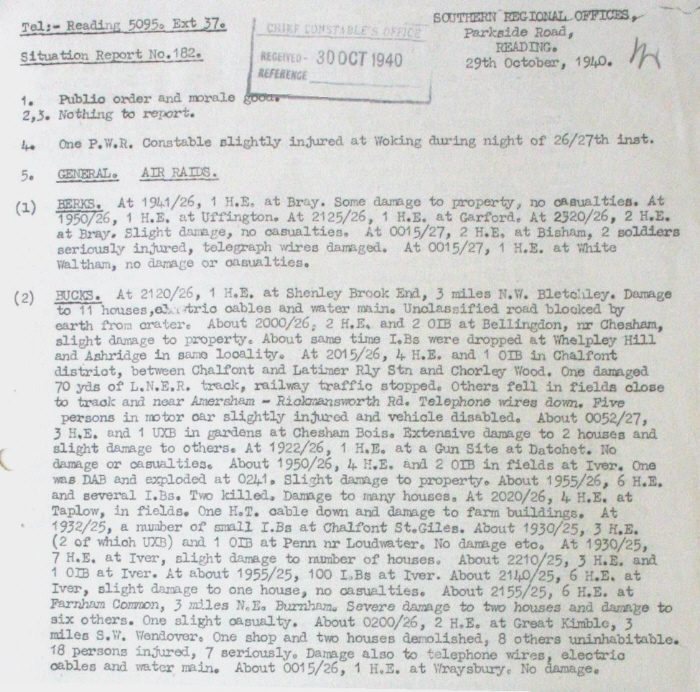Evacuated From London
The growth of Amersham-on-the-Hill during the
1930s meant there were many new houses for people to move into. A
lot of the people that moved into the houses came from London.
During the 1930s some moved just to leave the crowded city, but
others decided that with the possibility of war a move from
Central London would be a wise move. When World War II broke out,
more people moved out to towns like Amersham, either buying
property or staying with relatives. A number of children were also
evacuated either officially or unofficially to relatives. Local
schools gained extra pupils transferred out from London schools.
Doris Lediard, now from Oregon
recalls "I was one of many school children who were evacuated
from London at the beginning of the War. We were billeted in
Chesham and I rode the bus to classes at the Amersham
(Challoners ed?) Grammar School. Us girls from the Chiswick
County School shared the school with the Grammar School pupils,
they attended in the mornings and we went in the afternoons and
I think on Saturday mornings also. During the mornings our
school packed into a Scout Hut in the woods to do our "prep". It
stands out as one of my vivid memories, as to get to the hut we
had to go by a soldier who checked our identities. Also the hut
did not have any heat and many mornings the ink was frozen in
the ink wells, we were so cold that we worked in our overcoats
and hats. I especially remember a restaurant in the town whose
kind owner allowed us "evacuees" to sit in the warm and eat our
sandwiches, (it felt like heaven to us frozen girls)."
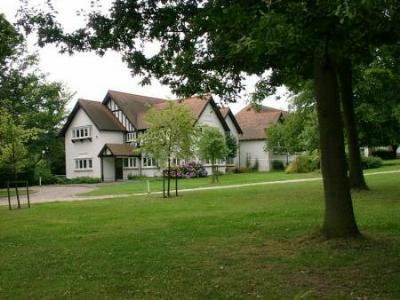
Dr. Challoners school would have been one of
the many local schools to gain extra children from families
moving out of London
Sylvia
Osinowo recalls "I was born in Amersham in
1937, my aunt Mrs Emily Chalwin had a very small general
grocery shop in London Road facing Waterworks Cottages, the site
is now Tesco. I lived in Waterworks Cotts with my mum,
dad and sisters, there were six cottages in the row at
the end of which was a tiny shop up a few steps owned by a
Mr. Pigott. These cottages and shop were very near Bury
Farm. There was a line of cottages on the other side of the road
leading up to the Police Station, some of them must have been
empty at the beginning of the war, because quite a few evacuee
families came to live in them and some stayed after the
war. There was also an empty public house called the
Wheatsheaf which housed several families. This was in the
middle of the row."
|
War Time Memories
The late Pete Wood, from Southern California,
recalls his memories of Amersham during the war -
"My father was mobilised on September 1st 1939 so my mother and
her 2 children (I was 5) went to her parents home in Amersham. The
address was then 47 Woodside Road which was later re-numbered to
115 and we lived there until Dad returned in 1945.
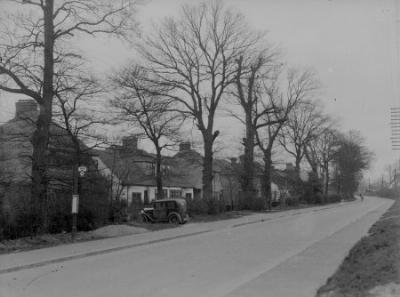
Woodside Road in the 1930s - Picture Courtesy of
Pete Wood
"We then bought a little house at 46 Orchard Lane and I lived
there until I was married in 1957. We moved in 1960 to California.
I remember the incendiary raid of 1941. The little bombs were
popping all around us and I found a live one next morning in King
George V Playing Fields, which backed onto my garden. The night
sky was as bright as day but fortunately no house fires were
started.
"It was also quite common to see Spitfires flying low over
Amersham chasing Nazi aircraft - truly memorable events in the
life of a young boy growing up in wartime. The air raid siren
outside Dr. Farquarson's house at Sycamore Corner always seemed to
go off after the aircraft were long gone!
"The citizens of Amersham did their bit too and purchased a
submarine for the Royal Navy. There was a huge "thermometer"
outside the bank at Oakfield Corner showing the weekly totals of
peoples' donations.
"On the night of VE day someone "found" 20 or 30 military signal
rockets and let them off on the vacant lot that later became the
post office on Hill Avenue - an awesome sight for a 10 year old
boy! Even after all this time there is a part of me which never
left Amersham and I have a lot of fond memories."
(The air raid siren Pete refers to above was used after the War to
call out the retained firemen. The siren brought back many memories
for the residents and continued in use into the 1970s. If the wind
was blowing in the right direction you could also here the siren in
Chesham).
David Woodridge now from Perth, Australia write
"There is some mention of dugouts in Rectory Wood, it must have
been just prior to "D" Day because at one stage Rectory Wood was
bursting at the seams with English soldiers and, mostly on the
south side, there were many dugouts and slit trenches. The old bus
station at the eastern end of the Broadway was used as a transport
depot, lots of army lorries and also tanks and I can remember
these tanks tearing up the road surface as they went up and down
the streets, quite terrifying as a little lad. The soldiers were
made to swim at the old Cygnet swimming pool amongst other things
and I remember the poor soldiers being made to swim in the
freezing conditions and they were absolutely blue with the cold.
Then all of a sudden all the soldiers disappeared so that must
have been "D" Day time."
Round by Pond Wicks next to the Rec. was "Amersham Prints" and they
amongst other things made balloon barrages and parachutes."
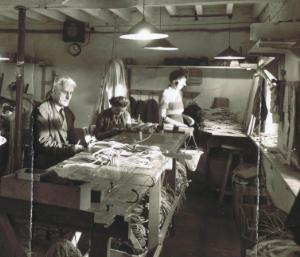
Picture Courtesy of David Woodridge
The rope/splicing workshop at Amersham Prints, off School Lane,
taken at 3. 56 pm some time during WW 2. They made parachutes,
inflatable boats and barrage balloons. There would be a need for all
sorts of roping. David can remember his father coming home and
practicing different knots and splices.
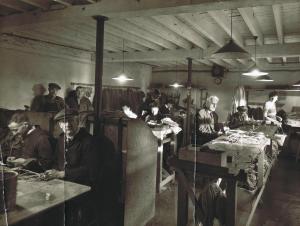
Picture Courtesy of David Woodridge
A more general view of Amersham prints show David's father, Bert
Woodbridge in his cap, top left. David writes "I'm afraid that
although some of the others look familiar I can't put a name to
them, I tried to enlarge the work bench and it is a little out of
focus but I noticed, with interest, that hanging on the wall at
the back, some very thick ropes that I would think would be for
the barrage balloons, those ropes on the work bench could be
anything."
Gerald Goldberg remembers various stories from his time in
Amersham during World War II. "With
regard to the glider that became detached, we saw that happen
overhead and myself and three friends saw the direction that the
glider took and followed across the fields for a couple of hours
and came across the undamaged glider and talked to the crew. We
were invited aboard the interior and were shown the cockpit plus
some weapons among which were hand grenades that they called their
“pineapples”. I was also in school when the bombs dropped nearby,
the school windows were blown out and our desks flew into the air
and we all ended on the classroom floor in shock. We also saw the
German plane that crashed at another time. There was an American
airbase a few miles away and us boys used to creep to their
rubbish dump and salvaged sticks of chewing gum and other sweets
thrown away. The only other thing that happened was that a large
convoy of troops that some of who had camped near our
cottage in a grass area. I talked to some soldiers who asked to
borrow a fish and chip frying pan. They also showed me their “iron
rations” which had some biscuits that were so hard that one was
nailed to a nearby tree. It’s amazing that these memories are
still vivid to me and that my grandchildren find hard to believe.
How times have changed but we owe so much to those wonderful
forces that protected us"
|
Air Raids
Lola Richards (nee Matto)
now from Canada remembers on her web site here (which includes pictures) her memories of the
War in Chesham Bois. "The worst part were the Air Raids. My Dad
constructed an Air Raid shelter in the house, made from a heavy
carpentry bench, with sheets of metal encasing the sides. We
crawled into the shelter from one end and had blankets and
pillows in there as we often had to hide for quite a while. The
only problem was, as soon as the siren sounded, our 3 large
Airedales would dash for the shelter and get in before us! We
would listen to the planes going overhead and got to know by the
sound of them whether they were 'Ours' or 'Theirs'. Then we
would hear the 'buzzbombs' going over, and pray that the noise
would continue. For when it cut off, that was when the bomb
would fall. Even now, when I hear the E.M.O. siren, I get a
sinking in my stomach, as it sounds just like the Air Raid
sirens used to. You never forget something like that. For light,
we had a lantern covered with green baize, and I can still
recall the smell of the warm cloth. Of course black-outs were in
effect so we couldn't have much light, even tucked away in the
shelter. As a child I was only aware of feeling safe and
protected in our hide-away. When the All Clear siren sounded, it
felt so wonderful! We would all pile out and my Mum would go and
put the kettle on to make a cup of tea!.
"However, one night it was different. Shortly after an
especially scary raid, my Mum was alarmed by the Bomb Disposal
Squad leader pounding on our door and telling us to evacuate the
house quickly. Evidently, they knew that one bomb had dropped
but had not exploded yet! My Mum always remembered wrapping me
up (I guess I was about 3 years old then) and taking me outside
to go to a neighbour's house, Mrs. Honour who lived on Woodside
Avenue. Our house was situated right across the Chess Valley
from Bovingdon Aerodrome and that was a prime target for bombs.
A German bomber had dropped a 'stick' of six bombs aimed at
Bovingdon, but unfortunately for us, his aim was a little off -
and they came across the valley dropping in a line up our side.
One was a direct hit on the goat shed at the far end of our
property - the poor goat never knew what hit him! The next one
fell in our back lawn - only yards away from where my Mum and I
were hiding in our home-made shelter. Not only did it land
there, but it turned underground and tunneled beneath the
house......but did not explode!
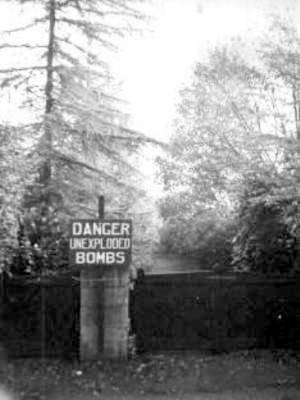
Sign outside Lola's Chesham
Bois house
"After evacuating us, the Bomb Disposal Squad dug down to defuse
and extricate the bomb. I have the greatest admiration for those
brave men! We were not allowed back home officially, but my Mum
sneaked back to feed the rabbits and chickens, and managed to
get some photos of the crew working. After the crisis was over
she made them all a cup of tea, of course!" The above
episode may be the one referred to below in the second extract
from the Surrey history Centre.
Referring to the bombs landing on King George V playing field
mentioned above David Hawley adds "I
note that the description of the Incendiary bombs was accurate
except that a house did get hit, our house, and if it was not
for the bravery of my brother Ray who was ahead of us going up
the stairs to bed, our house would have caught fire. The bomb
when it came through our roof landed on the floor of our large
bedroom on its fin [the mark was on the lino for many years] and
it bounced onto a marble topped dressing table. Ray entered the
room and using my eldest brothers best grey flannels, scooped up
the flaming bomb and ran down the stairs shouting 'open the
door' and he threw it into our front garden. His photo appeared
in a national paper I think it was The Sketch but I am not sure."
Frank Phillipson has
passed me details of some research he has doe at the National
Archives. He has found records which details some of the bombing
in the Amersham area. Some of the details are as follows
27 September 1940 - 6 bombs landed in Amersham Common, 5 of the
bombs were 50kg, covering an area of about half a mile. The assumed
target was the railway station. Most landed on open ground, some in
fields and one damaged a footpath and sewer cover. Apart from
craters, no other property was damaged.
18 October 1940 - 1 bomb landed in Chesham Bois. No casualties, the
bomb landed 14 feet from a bungalow which was "badly shaken".
15 November 1940 - 10 50kg bombs landed in the Coleshill area. No
casualties and open land or farm land hit
The detail shown on the Archive records is quite extensive, with
each bomb location noted with details of impact and damage caused.
James Fairbairn, now from perth, Australia
write - "I was reading with great interest your
Amersham during WW2 page – I grew up in Amersham (Elms Close &
Longfield Drive) in the 1970’s & 1980’s. An elderly neighbour
who lived on Longfield Drive at the time, Betty Radcliffe, (she had
lived in the same house since the street was build back in the
1930’s), told me that there was another bombing raid that doesn’t
seem to be mentioned on this website. I can’t recall what year, but
according to her sometime between ‘40 & ‘42 a solo bomber
dropped 3-4 large bombs in a line from Hervines Wood to what was
then the Cinema on Sycamore Road (where the Iceland Supermarket was
when I was growing up). I seem to recall the another landed in what
is now Dr Challenors playing fields. The impression was that it was
a bomber which had missed its intended target and was looking to get
rid of the payload before the flight home. The very large craters of
2 are still there to this day in Hervines Wood. I would be
fascinated to know if there is any archive information that
corroborates this story, or in fact any other witnesses alive that
remember the incident."
If anyone has any more details of raids, please email
the
web master
|
Flying Bombs
Pete Wood continues -
"I also recall a Sunday morning in the spring of 1944, a flying
bomb (Doodle Bug) landed in Chestnut Close (this may have been
Chestnut Lane - see below - Ed.) and demolished two houses and
killed several people. I still remember my stark terror as I
stood in my grandparents house in Woodside Road hearing the
pulse jet cut out and the swishing sound as the bomb plummeted
to earth not knowing if it was the last few seconds of my life.
The massive explosion shook the house but fortunately no windows
were broken. Perhaps some more of your readers have
recollections of these events."
Pete Wood has supplied the following pictures -
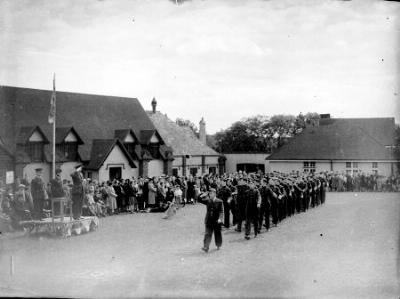 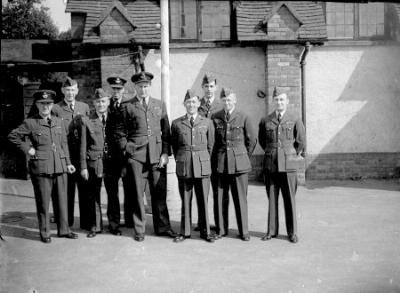
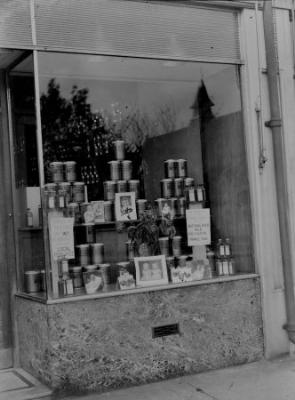 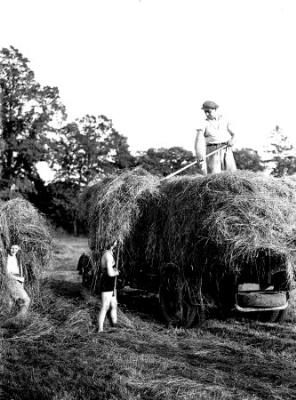
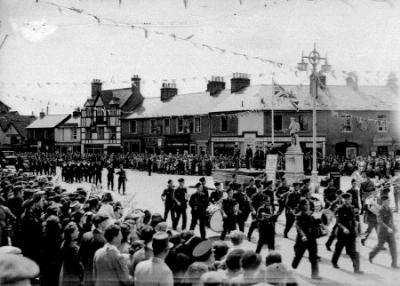
1411 Squadron at Dr.
Challoners, Officers of 1411 Squadron,
Dried Milk display and VE Day Parade in Chesham
See
here for all of Pete's pictures with full
descriptions
Malcolm Flack from
Amersham also remembers "Being born in Amersham
in White Lion Road a year before the commencement of the War, I
can recall as a child seeing what I now understand was a "Doodle
Bug" flying in a westerly direction towards the Chesham Bois
area and subsequently hearing a loud explosion. My family
decided later that day (a Sunday, I believe) to take a stroll in
that direction. We went along Parkfield Avenue to the end at the
junction with Chestnut Lane, where straight in front of us
behind the hedgerows were the remains of what was a fair sized
detached property which had been destroyed by that deadly
object. Nothing stood more than a metre high as far as we could
see."
Since receiving the above information, I have been advised that
the first "Doodle Bugs" were not launched until June 1944, spring
could be described as June, but memories of over 60 years ago
should allow for this. There has also been a suggesting that no
flying bombs landed north of London. My research on this matter
definitely reveals there was a large explosion which destroyed a
house in Chestnut Lane. Whether it was a V1 is less clear, it
appears they did land north of London and it also appears much dis
information was given out to try and confuse the Germans on the
success or otherwise of their attacks. If anyone can provide any
more details on this incident, I would be very grateful. I am
indebted to Frank Phillipson
who has contacted me and writes "... I have found from "The
Defence of the UK" by Basil Collier IWM 1957, that 27 flying
bombs (V1s) landed in Bucks and that 2 V2s landed in Bucks
during February 1945. This is backed up from information from
the Centre for Bucks Studies in Aylesbury."
Malcolm Hutton now from Melbourne, Australia has added
the following - "I have just come across your web page and
this has answered a question that has been in my mind for
decades. I was born in June 1933 in Co. Durham but we
lived in Pinner from November 1936. Most of my mother’s
family had lived in Bucks for years. Auntie Jenny had
the Stores in Hyde Heath, Grandma and Grandad retired to Hyde
Heath, Uncle Oliver was at Chesham Bois in later years, but
Uncle Jim and Aunt Elsie Draffan had lived in the Tiled
Cottage in the lane opposite the station at Little Chalfont
for many years. After the war Uncle Dick Draffan
had the grocery shop in Prestwood, later to be enlarged into a
supermarket which I see is now a Co-op store.
Consequently we spent many weekends at Hyde Heath or Little
Chalfont. I remember the Doodle Bug so well. It
had to have been on a Sunday and it was somewhere around mid
morning. Auntie Elsie was in the kitchen, Mum and Dad were in
the lounge and Uncle Jim had just gone to the loo! He
had always said that if there was one overhead he would be
sure to be on the toilet. There was horror for a moment when
that awful throbbing groaning noise was overhead, and I know
somebody said it’ll be alright if we hear the engine stop,
which it did just then. Seconds later we were under the Grand
Piano. I seem to remember the crumping noise, but could that
be imagination now?
I know it had to be in the morning because
afterwards Uncle Jim, Dad and myself made our way up the road
to the Pub where I always had to sit outside with a lemonade.
The next big Sunday that sticks in my mind
on another weekend at Little Chalfont was just before D-Day,
though I wasn’t sure what that meant at the time. This time we
were on our way back to Tile Cottage from the Pub looking
forward to Sunday Roast, when the convoy came
through. We got stuck on the Station side of the
road for what must have been a good half hour, before we could
cross the road to the steps that short cut up to the
Lane. Does anybody know which Sunday it was when the
D-Day convoy passed through Little Chalfont? I can only
guess at 28 May, 1944.
I have so many fond memories of Hyde
Heath, Amersham and Little Chalfont, especially Uncle Jim’s
Lawn next to the house and overlooking the railway line where
we used to play croquet. In later years my cousin June
got married and had a house built where the lawn was.
So
that fateful day had to be 2nd July, 1944. Many thanks
for helping make these memories come back."
Mike Smith from Chesham Bois
has supplied further information about the bombings in Amersham. "Inspired
by your website I have been looking up the records (ARP reports)
at the Centre for Buckinghamshire studies.
"I believe there were probably four flying bombs in the Amersham
area, including the following three specific incidents:
"The first of these was the one in Chestnut Lane, which fell at
10.52 or 10.54 am on 2nd July 1944. The report says 'Red Lodge
and Bungalow (part of the same property?) completely demolished.
Northcott partly demolished. The Leys severely damaged. Two
other houses badly damaged. Many houses and shops in Bois Lane,
Chestnut Lane, Woodside Avenue and Sycamore Road suffered severe
damage.'
"Another report says '1 house completely demolished (5 yds away
from Flying Bomb) 4 houses partly demolished (10 and 55 yds
away) 135 houses damaged (ceilings, roofs, windows) (within 200
yds radius)'.
"Casualties were 'Killed 1 male 1 female. Admitted to Amersham
Emergency Hospital 3 males 10 females 1 child. Other minor
casualties, chiefly cuts from glass'.
"The next was at 17.55 on 5 July 1944 at Windmill Plantation,
Weedon Hill Wood, Amersham. The report says '12 houses within a
radius of 400 yds (badly damaged?). Damage to ceilings, tiles
and glazing to other houses within a 1/2 mile radius'.
"The third was on 16 August 1944, 1/2 mile SE of Ley Hill
Common. This seems to have been on open ground as no damage was
reported."
David Hawley, now from Aylesbury has
contacted me and writes "I was born in 1935 at 26 The Meadows
and have a few memories of events I witnessed during World War
2. I can confirm that a Doodle Bug did in fact land in Chestnut
Lane. I was standing on a footpath opposite No. 20 The Meadows
where the Brackley family lived and was with an evacuee named
Louis Kerner who lived at No 20. We both heard the noise of the
Bug as it passed over The Meadows and saw it just before its
engine stopped then saw it start to fall, at this Louis ran into
his house and I ran to tell my Father and as I was going through
our Back door there was a loud explosion. My Father and I could
see a plume of smoke, he then took hold of my hand and we went
to the end of our garden and over the fence into his railway
allotment, up the bank and over the railway and through a hole
in the fence and then along the edge of the cricket ground down
to, and over, Woodside Road up Mitchell Walk into Plantation
road into New Road and then into Chestnut Lane. The first thing
we saw was the side of one house which had been damaged and a
couple standing by a cooker outside the house. All they said to
my Father was 'we've lost our Sunday Dinner'. We carried on
until we saw the house or bungalow that had been virtually
flattened, other houses were damaged but my Father said 'this is
where it landed' "
I am very grateful to Richard
Doust who has provided the
below following research he has undertaken.
I have been doing research on Bovingdon Airfield, and I
came across a photograph from the US national archives with the
description: Aerial view of houses damaged
by a buzz bomb which hit the residential area in Bovingdon,
England, on 2 July 1944. I
was unable to identify a location in or around Bovingdon
village, which matched the photograph (even with the aid of
Google Earth and old aerial photos).
Reading through your pages on flying bombs
in the area, Mike Smith had
provided accounts from ARP reports, which detailed a flying
bomb on the 2 July 1944 in Chestnut Lane, Chesham Bois. Using
imagery from Google Earth, I have matched the three houses
on the junction of Chestnut Lane and Parkfield Avenue,
Chesham Bois, to those in the photograph.
On the original photograph
towards the top, you can see two boys trying to get a
glimpse of the bomb site through a gate from the path.
Another
thought around the photograph, was whether it was taken
specifically to review the damage caused by the bomb, or
if an aircraft was on an approach run into Bovingdon
Airfield. If you draw a line from the location the
photograph is taken, to Bovingdon Airfield, it pretty
much lines up with approach to the main runway.
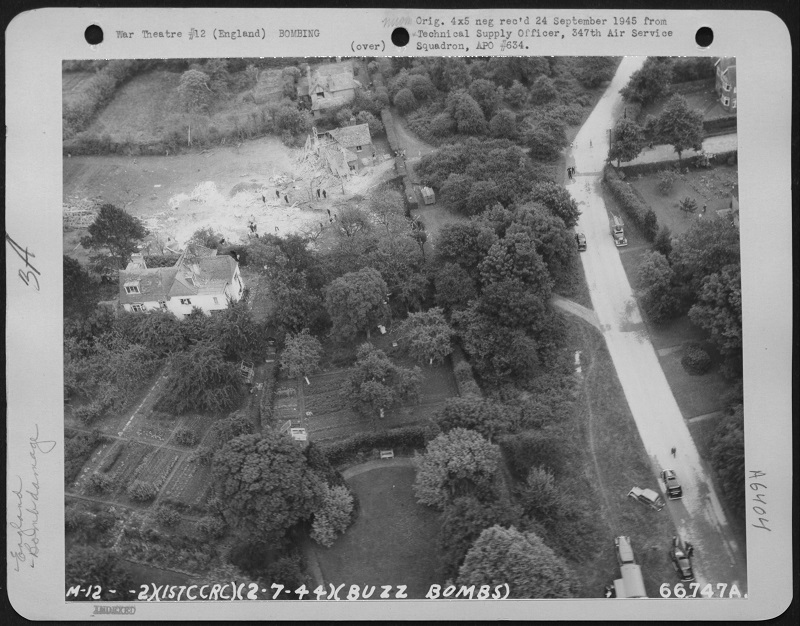

Google Earth View of Bomb Location
- Chestnut Lane / Parkfield Avenue
|
Aircraft Crashes
Frank Phillipson has
researched an incident that occurred in Little Chalfont. In the
book "Raiders Overhead" by Stephen Flower (about air raids on the
Walton and Weybridge area of Surrey) reference is made to a
Halifax bomber being accidentally shot down by British anti-
aircraft guns sited near Weybridge and Slough on 24th March 1944.
The aircraft crashed at Lodge Farm, south-east of Little Chalfont
(the farm is south of the railway and east of Lodge Lane). A
database of bomber losses reveals the following details :-
Type:- Handley Page Halifax II (Merlin engines) Serial No.JD317
Unit:- 1659 HCU (Heavy Conversion Unit i.e. training crews to fly
four engine heavy bombers).
Operation:- Diversionary attack on occupied France west of Paris.
Date:- 24th March 1944
Airborne at 19:22hrs from RAF Topcliffe the Halifax was part of a
diversionary force made up of 147 older bombers from training
units. The diversion was in support of the Main Force bomber
operation against Berlin of 811 aircraft.
Halifax JD317 steered for an area west of Paris but, on the return
leg to base, the aircraft strayed into the London Defence Zone and
was shot down at 23:00hrs by AA fire. It crashed in flames at
Lodge Farm, Little Chalfont, Buckinghamshire killing the pilot F/O
MS Little RCAF who is buried in Brookwood Military Cemetery. Three
injured members of crew were admitted to hospitals at Amersham and
Watford suffering from sprains and shock:- P/O J.S.Beresford RCAF,
Sgt J.Mackenzie RCAF, Sgt N.E.Cowan RCAF.
Further research reveals there was an unusually strong northerly
wind which blew the Halifax over 100 miles off course over the
London Zone. The pilot was praised for staying at the controls of
his aircraft steering it away from "a village" and saving his
crew. It appears the Halifax did not identify itself to the London
Defence Zone, hence the error in shooting it down.
Malcolm Flack from Amersham
remembers "I recall seeing some sort of plane (I have no idea what
type etc.) stuck in the trees in Lodge Lane Little Chalfont. The
exact location was after you go under the railway bridge in Lodge
Lane from the Amersham-Rickmansworth Road and at the bend in the
road after the dip, it was on the left just before Long Walk
turning."
Pete Wood recalls - "In
1943 (I think), a Lancaster bomber crash landed at night in a
field bordering Stony Lane. The next morning, I furiously cycled
over there and sure enough there was the Lancaster with its
wheels in mud up to the axles and missing the left wing-tip. The
pilot had done an amazing job in landing it, but two oak trees
at the edge of the field were a little closer together than the
wing span. When I got there, the aircrew had already been picked
up and the aircraft was being guarded by an RAF corporal. I
found the left landing light some distance away and persuaded
the corporal to let me have it. The reflector was crushed by the
impact but the bulb with a filament that looked like a gate
spring still worked and I kept it for many years.
Richard Martin writes - "I
came across your website after doing a bit of searching to verify
the story of a Lancaster crash landing at Amersham in World War
II.
The incident is detailed in the book 'Boys at War' by Russell
Margerison who was an air gunner on the Lancaster PED940 which
landed with wheels down after running out of fuel. In the book,
Russell Margerison writes: We
had, in fact, touched down in a small field in Little Chalfont,
Buckinghamshire, where we had run parallel to the A404 Amersham
to Watford Road, some thirty yards from the backs of the houses
there, ploughed through a small hedge and crossed Stony Lane,
climbed up a banking and passed through some small trees, Max
having chosen the widest gap. Unfortunately the gap had not been
wide enough to cope with the 102 foot wingspan and consequently
half of the port wing was left neatly wrapped around the largest
of the trees. A pig pen had been demolished and a small hole had
appeared in my turret. But there, at Great House Farm, part of
the Duke of Bedford's estate, PED940 stood proudly, having
completed the last of her operations, still undefeated. She
would now have to be dismantled and removed piecemeal."
David Hawley writes "I
wonder if any of your site visitors were in the the Black Horse
Primary School sports field the day that a two engined German
plane flew over it with an airman on its wing. It crash landed
in a field at Raans Farm and after school we went and saw it and
by this time the Home Guard were there with the German airmen."
Richard Ayres now from Staffordshire
recalls that one of the gliders from the force that set out for
Arnhem in 1944 came down in Rogers Wood Field, to the south of the
River Misbourne.
David Hawley adds "I also
remember the glider incident as myself, plus the Brackley
brothers went to see it. I remember the soldiers were not very
happy, they did not know then how lucky they had been. I also
witnessed from the top of Stanley Hill the recovery of the
Glider by a Wellington aircraft from a hook line that had been
erected."
Evidence of Air Raids and Aircraft Crashes
From The Surrey History Centre
Further research undertaken by Frank
Phillipson has revealed some interesting records
about events in the Amersham area. The Southern Regional Civil
Defence area included Bucks and situation reports viewed at the at
the Surrey History Centre (Surrey was in the same Region as Bucks
until March 1941) provide a record of events.
|
Special Training School XX
Nigel Woof from
Chalfont St. Giles writes "two houses in
Pollards Wood - Pollards Park House and Pollardswood Grange -
(near the site of the Amersham plc site today) were
requisitioned in 1941 and became 'Special Training School XX'
(i.e. number 20) of the Special Operations Executive, better
known as SOE and recently popularised by the Sebastian Faulks
novel 'Charlotte Gray' and the film of the same name.
STS20 was apparently used to train Polish section SOE agents in
clandestine operations. The Polish SOEs activities included
operation WILDHORN in 1944 and '45 in which British / Polish
aircraft were covertly landed to bring out key Polish
underground / resistance leaders and return them to England. In
one of these missions in July 1944 a captured V2 rocket was also
apparently brought out.
I know of no accounts by local residents of the goings-on in
Pollards Wood during the war, but presumably many suspected
there was something 'hush-hush' happening there! Would be
fascinating to know if anyone remembers."
For details of Operation Wildhorn, see www.operationwildhorn.com
|
|
|
|
|
Henry Allen Nursery School
An interesting story concerns the creation of the
Henry Allen Nursery School. In the early 1940s, there became a
need for the provision of nursery places for the pre-school age
children of Amersham and the surrounding area. Many local women
were employed in war work (Amersham Prints in The Maltings, had
been taken over to manufacture barrage balloons and The Cartwheel
in London Road made radios). In 1941, before the bombing of Pearl
Harbour which resulted in America entering the Second World War,
Californian subscribers to the American Save the Children
Federation provided the money required to build a Nursery as a way
of aiding the British war effort without becoming involved
militarily. The President of the Federation was Governor Henry J
Allen of Wichita, Kansas. In 1941 he traveled to Amersham to turn
the first spadeful of earth that marked the beginnings of the
Nursery. The site chosen was a piece of farmland adjoining
Mitchell Walk, which at that time was an unmade road (remaining so
until 1960) with only one house. On 9 February 1942 Henry Allen
Nursery opened its doors for the first time with places for forty
children aged two to five, although occasionally babies as young
as eighteen months were admitted if their mothers work was
essential to the war. The two classrooms were named after the
Royal princesses; the old children were in Elizabeth Room (now
Purple Class) and the younger ones in Margaret Room (now Red
Class). (This information has been kindly supplied by the Henry
Allen Nursery School, for further information see the School's web
site LINKTO<'"
designtimesp=9114>here
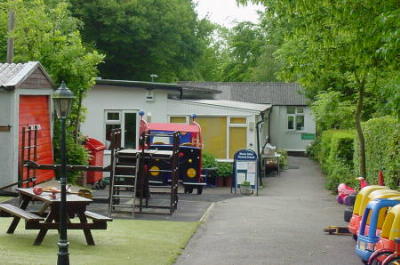
Henry Allen Nursery School (Picture Courtesy of
Henry Allen Nursery School)
|
Shardeloes War Time Maternity Hospital
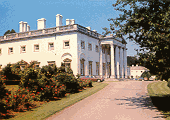
Shardeloes
Picture Courtesy of Bridget Clarke
During World War II Shardeloes, on the outskirts
of the Old Town, was converted into a maternity hospital for
people from London to come out to the countryside to have their
children, over 5200 children were born there by the time it closed
in 1948. I receive quite a few mails from people born at
Shardeloes. Some have posted on the Amersham
Forum asking for others to contact them.
I am grateful to Kathleen (Dorothy
Cutting) Wachholz, now from Canada
for
telling
emailing -
"I
was born at Shardeloes on September. 3, 1944 - actually I was
the 3,000th baby. I have a paper clipping of a visit by the
then Princess Royal on September 12, when I was 9 days old.
I guess I had my 15 minutes of fame at an early age"
Kathleen
has kindly provided a copy of the paper cutting, which is
shown below (the actual text is repeated below the image)

The
Evening News - September 21, 1944!
"3,000 BABIES
Born in Mansion
THE QUEEN CALLS TO
SEE "LITTLE LONDON"
"Evening News" Reporter
One of the stately homes
of England, a house steeped in history and tradition has
become the war-time birthplace of over 3,000 children, most of
them he babies of London parents.
The Mansion-cum-maternity
home is Shardeloes, ancient seat of the Drake family at
Amersham, built by Robert Adam in 1760, and home of the
present Lord of the Manor, Captain Thomas Tyrwhitt-Drake, M.C.
Captain Thomas
Tyrwhitt-Drake moved out of the house when the war started and
went to a less pretentious so that Shardeloes could be
turned into an emergency home.
It is probably the biggest
home of its kind in England and almost certainly the grandest
for it stand in its own park of 700 acres.
One Every Day
A day never passes at
Shardeloes without a baby being born. Up to to-day 3,024
(it looks like 2,024, but I think it must be a typo) have
been brought into the world there since September 1939 - an
average of five every three days. The number includes
dozens of twins, but the staff is still waiting for the first
triplet -r or more.
The accommodation of 55
beds is always full and the staff of 20 is kept busy night and
day.
The Queen and the
Princess Royal have both called at Shardeloes. When
the Princess Royal was there recently she saw the 3,000th
child to be born there, the six-day-old daughter of Mrs.
Grace Cutting of Trinity Road, Tooting.
May thanks to Kathleen for creating the above text from the
clipping.
|
ARP, Home Guard, Military Bases
In the book "Yesterday's Town: Amersham" by
Nicholas Salmon & Clive Birch - Copyright 1991, ISBN 0 86023
486 X it states that the Amersham section of the territorial Army
joined with other sections to form the 1st Bucks Battalion.
Amersham had first aid posts set up at the ARP Centre, Sycamore
Road, While Lion Road. Elmodesham House in the High Street became
the area head quarters for defence.
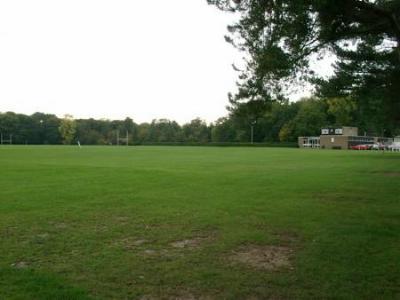
Hervines Park / Hervines Woods
Hervines Park and Shardeloes Park were converted for farm use and
the new "greens" in the newly built Woodside and Highfield Closes
were turned into allotments. As well as the purchase of the
submarine which Pete Wood mentions above - which unfortunately was
never named "Amersham", but was adopted and was called H M S
Unbroken - the town's residents during the War raised funds to
help purchase aircraft and tanks.)
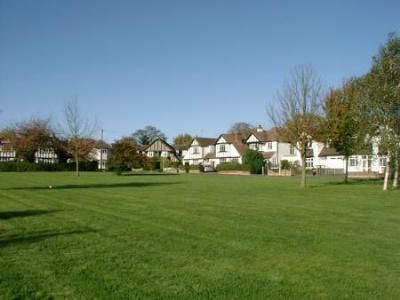
Woodside Close Toady
On the corner of Woodside Road and Sycamore Road (where Hopper
& Babb is now) the War Food Office issued ration books. The
Maltings in the Old Town was used to make barrage balloons and The
Cartwheel on London Road made radios.
Around Amersham in Rectory and Pipers Woods and at Hodgemore army
camps were set up. The camp at Pipers Wood was by occupied at
various times by the King's Own Scottish Borderers and also by the
Americans and was used after the war as a reception centre for
returning prisoners of war. The camp at Hodgemore became the home
to a large contingent of Polish servicemen. The camp remained in
existence well into the 1950s with its own shop and post office.
|
|
|
|
The Radio Chemicals Centre
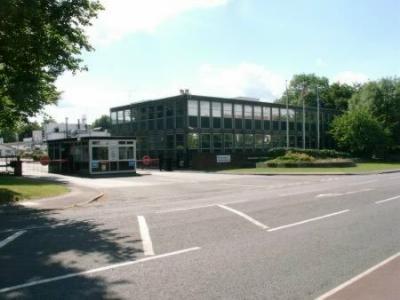
The Radio Chemicals centre / Amersham plc now
part of GE Health Care
In 1940 a company was set up on White Lion Road to make luminous
paint based on radium. This site grew and after the war formed the
basis of the Radiochemical Centre, which in turn became Amersham
plc, now part of GE Health Care. The complex along with other
sites in the area is now one of the areas largest employers.
Although having been created during the War, the centre has moved
its focus into the medical industry.
|
Amersham Hospital Develops
By the outbreak of War, The Work House in Whielden
Street had divided into The Amersham Public Assistance Institute
and St. Mary's Hospital. Part of the site was then commandeered to
become an "Emergency Services Hospital" serving the military and
civilians. "Temporary" buildings were erected to form wards and
operating theatres in 1939/40. They were built by Canadian Forces
and these temporary buildings remained in use until the end of the
1990s. There were 280 beds in the temporary hospital and 138 in
the old work house part. St. Mary's Hospital in Paddington
assisted in the running of the hospital. (Thanks to the Amersham
Society for information) See the Amersham Hospital page here for more
details.
|
Evidence of World War II
In parts of Amersham, there are still traces of
World War II. Richard Ayres now from
Staffordshire writes "if one walks up the
footpath from the church through Tenters Field one enters
Rectory Wood: turn right on entering the wood and adjacent to
the footpath there are the remains of trenches dug by Amersham
Home Guard (Brazil's Division) in 1940 - my father was one of
those who helped dig them.

View from Rectory Woods, probably the view from
the trenches
"There is also a footpath leading from the bottom of Station
Road through Ruccles Field (part has now been hard-surfaced to
provide access to Tescos). Before reaching Tescos, on the left
and most of the year hidden by grass and nettles, is a concrete
machine-gun emplacement, again dating from 1940."
I have also been advised that there is evidence of trenches to be
found in Hervines Woods, near Longfield Drive.
Ed Griffiths from Prestwood has
provided more information about the gun emplacement mentioned
about - "this is in fact a World
War II Home Guard ‘spigot mortar’ position." It is
not always easy to spot this, but Ed has provided more details of
how to spot it "The emplacement
is next to the footpath, up against the fence of the small
holding. If you leave Tesco's car park by the bridge
over the stream (River Misbourne), turn right towards Station
Road, the emplacement is on right of the path next to chicken
sheds (right by path)."
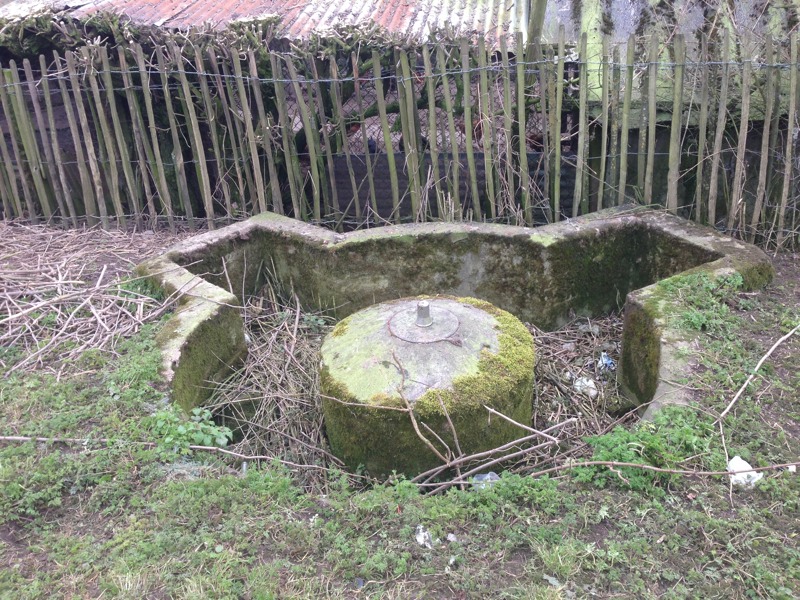
The above picture of the spigot mortar position was taken in March
2013.
It seems quite a few of these type of positions
were created during the War and their design would allow the area
to be covered by the mortar to be large, but why one was located
in this part of Amersham is a puzzle.
|
High & Over
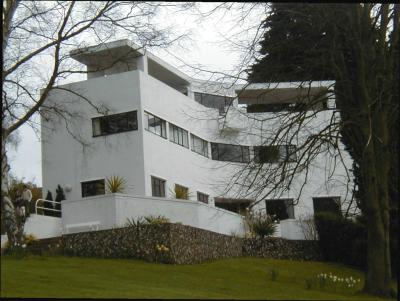
Picture Courtesy of Ian Halley
Whether it is an urban myth or not I'm not sure, but I have been
told that the High and Over house, off Station Road (above),
during World War II it had to be camouflaged, because it was built
in the shape of a letter "Y" . The reason being that the
distinctive shape of the house gave directions to German bombers
on their routes to their targets in Britain.
|
| You may find a
dissertation by Bob Stonnel about life as a school boy in Amersham
during World War II of interest, see here |
If anyone has any
memories or further information about Amersham during World War II,
I would be delighted to hear from you. I believe it is important to
record these memories so we can appreciate what life was like during
the War. Please email the
web master
|



